some rebuild questions, pics included
#1
some rebuild questions, pics included
I have been working on tearing down an engine for the rx7 I picked up this spring. Plan is to rebuild it as the hoses were rock hard and the car has 100000 km on it so wouldn't hurt to rebuild it.
1. what's a good rebuild kit to go with? I've read that some people don't like the Atkins apex seals, I think I've also heard that the rotary aviation oil control o-rings can be a pain.
I plan to keep the engine nearly stock, I'll probably port the waste-gate so I can open up the intake a bit and maybe a new inter-cooler. but i don't want to go so far that I have to switch ECU's and upgrade the fuelling.
2. what's the best way to clean off all the carbon build up on the rotors? my rotors are pretty much coated, I find my parts washer does next to nothing and I have to scrape it all off.
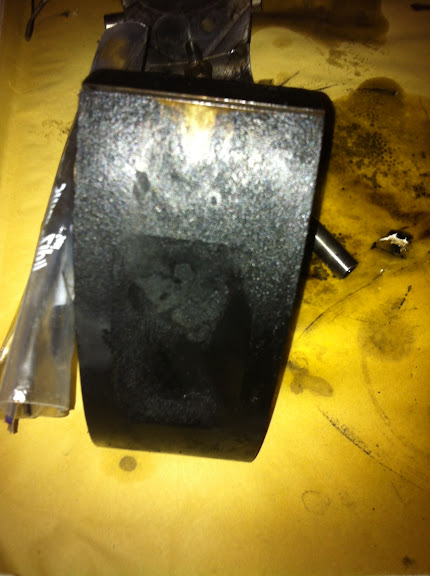
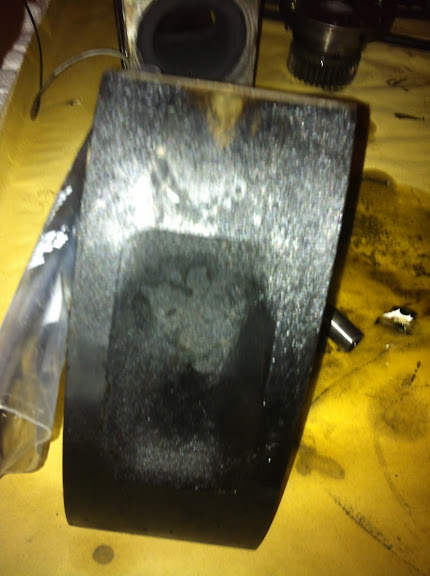
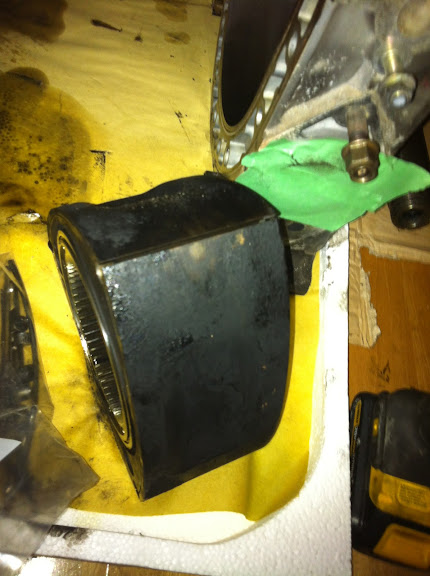
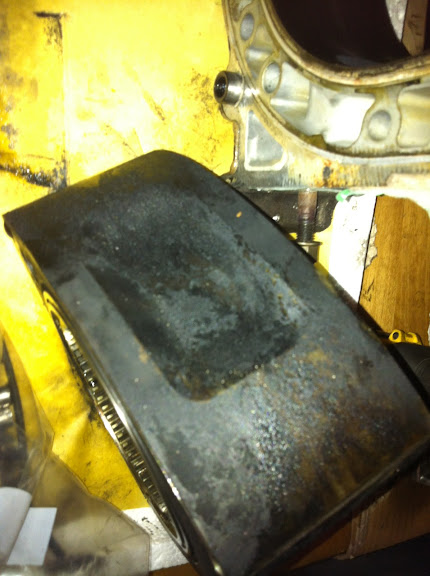
3. what else should I replace with the rebuild? a friend of mine says that its a good idea to replace something to do with the oiling. some valve that prevents oil while cold and opens when warm, but he said they eventually fail and that they fail closed. I guess someone makes a replacement one that's always open, who makes that. also I think that rotary aviation makes an adapter so that the oil for the combustion chamber can be drawn from a 2 stroke container rather than the **** from the bottom of the oil pan. should i look into this? any other small upgrades that should be made during a rebuild?
I think I got a few more questions that I came up with but they are slipping my mind as of now so I guess I'll post them when I remember. I'll post some more pictures of the torn down engine for entertainment. I'm just starting cleaning so I have some time to order the rebuild kit. I probably won't likely have the car insured and driving till next spring any ways.




1. what's a good rebuild kit to go with? I've read that some people don't like the Atkins apex seals, I think I've also heard that the rotary aviation oil control o-rings can be a pain.
I plan to keep the engine nearly stock, I'll probably port the waste-gate so I can open up the intake a bit and maybe a new inter-cooler. but i don't want to go so far that I have to switch ECU's and upgrade the fuelling.
2. what's the best way to clean off all the carbon build up on the rotors? my rotors are pretty much coated, I find my parts washer does next to nothing and I have to scrape it all off.
3. what else should I replace with the rebuild? a friend of mine says that its a good idea to replace something to do with the oiling. some valve that prevents oil while cold and opens when warm, but he said they eventually fail and that they fail closed. I guess someone makes a replacement one that's always open, who makes that. also I think that rotary aviation makes an adapter so that the oil for the combustion chamber can be drawn from a 2 stroke container rather than the **** from the bottom of the oil pan. should i look into this? any other small upgrades that should be made during a rebuild?
I think I got a few more questions that I came up with but they are slipping my mind as of now so I guess I'll post them when I remember. I'll post some more pictures of the torn down engine for entertainment. I'm just starting cleaning so I have some time to order the rebuild kit. I probably won't likely have the car insured and driving till next spring any ways.
#3
Engine, Not Motor
iTrader: (1)
Joined: Feb 2001
Posts: 29,793
Likes: 119
From: London, Ontario, Canada
1. Atkins kit is fine. You'll find everyone has a different opinion but Atkins seals have been proven reliable for many years. The exact kit you buy will depend on the wear level of your engine. For example, under 100K you probably don't need bearings.
2. Carburetor cleaner, and labor. Scrape the faces with a razor blade then blast it all down with carb cleaner. Let it soak, then use a Scotch Brite (red) pad to scrube it down. Scrape the side seal grooves using carb cleaner and an old side seal, same with the apex grooves. Oil seal grooves usually can be cleaned with a brass brush and carb cleaner. It just takes effort.
3. He's referring to the oil thermo pellet. Comes in the Atkins kit. It's honestly not a critical issue. Everyone says they can fail, yet I've never heard of one actually failing.
These videos will help you in the process of rebuild a 13B or 12A engine. While they deal with an older 13B from an RX-5 Cosmo, the engine internals are basically the same for any 12A or 13B. The only real difference is that on engines newer than '85, the coolant o-rings are in the irons instead of the housings as shown in this video.
The first video is engine removal. While it is an RX-5 Cosmo, an car that few will ever see let alone work on, the process will give you the general idea of an engine removal. Steps are similar for most rotary vehicles, it's the details that differ.
The next video is engine disassembly and some cleaning. This is an old carbureted 13B so the accessories bolted to the engine are different than newer engines. However the process of externally disassembling any rotary is about the same. Covered here is also flywheel removal (same for any rotary) and engine parts cleaning.
Cleaning of all engine parts continues in this video. Provided here are examples of how this is accomplished with a minimum of tools and supplies. It's a lot of labor to clean old parts until they are looking new again. At the same time, parts should be inspected.
Finally, here is the engine assembly. This video includes clearancing side seals, assembling all the seals onto the rotor, then assembling all the parts into a 13B short block.
2. Carburetor cleaner, and labor. Scrape the faces with a razor blade then blast it all down with carb cleaner. Let it soak, then use a Scotch Brite (red) pad to scrube it down. Scrape the side seal grooves using carb cleaner and an old side seal, same with the apex grooves. Oil seal grooves usually can be cleaned with a brass brush and carb cleaner. It just takes effort.

3. He's referring to the oil thermo pellet. Comes in the Atkins kit. It's honestly not a critical issue. Everyone says they can fail, yet I've never heard of one actually failing.
These videos will help you in the process of rebuild a 13B or 12A engine. While they deal with an older 13B from an RX-5 Cosmo, the engine internals are basically the same for any 12A or 13B. The only real difference is that on engines newer than '85, the coolant o-rings are in the irons instead of the housings as shown in this video.
The first video is engine removal. While it is an RX-5 Cosmo, an car that few will ever see let alone work on, the process will give you the general idea of an engine removal. Steps are similar for most rotary vehicles, it's the details that differ.
The next video is engine disassembly and some cleaning. This is an old carbureted 13B so the accessories bolted to the engine are different than newer engines. However the process of externally disassembling any rotary is about the same. Covered here is also flywheel removal (same for any rotary) and engine parts cleaning.
Cleaning of all engine parts continues in this video. Provided here are examples of how this is accomplished with a minimum of tools and supplies. It's a lot of labor to clean old parts until they are looking new again. At the same time, parts should be inspected.
Finally, here is the engine assembly. This video includes clearancing side seals, assembling all the seals onto the rotor, then assembling all the parts into a 13B short block.
#4
Yeah i would get rid of the stock oiling system..that's why your rotors are so carboned up.
Here is a link to the pumps........
Oil inject. Pump Adpt
or you can just premix with 2 cycle oil....half or a full qt. per full up. Half is fine, full qt. generaly for race it's just your own preference. I use Pennzoil Marine 2 Cycle oil it's about $17 a gallon . I have seen it real world aviation tested against other brands at twice the cost...good stuff.
I would rebuild with Goopy or ALS apex seals. They are indestructible will not shatter and ruin you engine if something goes wrong. They handle detonation better.
Here is a link to the pumps........
Oil inject. Pump Adpt
or you can just premix with 2 cycle oil....half or a full qt. per full up. Half is fine, full qt. generaly for race it's just your own preference. I use Pennzoil Marine 2 Cycle oil it's about $17 a gallon . I have seen it real world aviation tested against other brands at twice the cost...good stuff.
I would rebuild with Goopy or ALS apex seals. They are indestructible will not shatter and ruin you engine if something goes wrong. They handle detonation better.
#5
Moderator
iTrader: (3)
Joined: Mar 2001
Posts: 31,203
Likes: 2,826
From: https://www2.mazda.com/en/100th/
I have been working on tearing down an engine for the rx7 I picked up this spring. Plan is to rebuild it as the hoses were rock hard and the car has 100000 km on it so wouldn't hurt to rebuild it.
1. what's a good rebuild kit to go with? I've read that some people don't like the Atkins apex seals, I think I've also heard that the rotary aviation oil control o-rings can be a pain.
I plan to keep the engine nearly stock, I'll probably port the waste-gate so I can open up the intake a bit and maybe a new inter-cooler. but i don't want to go so far that I have to switch ECU's and upgrade the fuelling.
2. what's the best way to clean off all the carbon build up on the rotors? my rotors are pretty much coated, I find my parts washer does next to nothing and I have to scrape it all off.
3. what else should I replace with the rebuild? a friend of mine says that its a good idea to replace something to do with the oiling. some valve that prevents oil while cold and opens when warm, but he said they eventually fail and that they fail closed. I guess someone makes a replacement one that's always open, who makes that. also I think that rotary aviation makes an adapter so that the oil for the combustion chamber can be drawn from a 2 stroke container rather than the **** from the bottom of the oil pan. should i look into this? any other small upgrades that should be made during a rebuild?
I think I got a few more questions that I came up with but they are slipping my mind as of now so I guess I'll post them when I remember. I'll post some more pictures of the torn down engine for entertainment. I'm just starting cleaning so I have some time to order the rebuild kit. I probably won't likely have the car insured and driving till next spring any ways.
1. what's a good rebuild kit to go with? I've read that some people don't like the Atkins apex seals, I think I've also heard that the rotary aviation oil control o-rings can be a pain.
I plan to keep the engine nearly stock, I'll probably port the waste-gate so I can open up the intake a bit and maybe a new inter-cooler. but i don't want to go so far that I have to switch ECU's and upgrade the fuelling.
2. what's the best way to clean off all the carbon build up on the rotors? my rotors are pretty much coated, I find my parts washer does next to nothing and I have to scrape it all off.
3. what else should I replace with the rebuild? a friend of mine says that its a good idea to replace something to do with the oiling. some valve that prevents oil while cold and opens when warm, but he said they eventually fail and that they fail closed. I guess someone makes a replacement one that's always open, who makes that. also I think that rotary aviation makes an adapter so that the oil for the combustion chamber can be drawn from a 2 stroke container rather than the **** from the bottom of the oil pan. should i look into this? any other small upgrades that should be made during a rebuild?
I think I got a few more questions that I came up with but they are slipping my mind as of now so I guess I'll post them when I remember. I'll post some more pictures of the torn down engine for entertainment. I'm just starting cleaning so I have some time to order the rebuild kit. I probably won't likely have the car insured and driving till next spring any ways.
2. i scrape with a razor blade, then sand paper.
3. when in doubt there is a section in the FSM that details how to build the engine, and there is a specs page in the back that lists all the measurements and tolerances, so when in doubt, measure, and it makes life simple. the shop manual is here Foxed.ca
#6
Thanks Aaron. I've seen all your engine related videos already. They are very useful.
I'm slowly working through the cleaning, I have a parts cleaner, picked up some scotch bright pads today. They are a pain in the *** the arn't taking the gunk off of the side of the housings very fast. Might take a while to finish them.
I've started scraping the rotors with a razor blade and it seems to work a ton better.
Got some more questions I came up with.
4. I plan on sticking with the stock ecu, from my understanding as long as you can keep it under 10psi of boost your fine. So could I port the exhaust manifold and the exhaust runners and stuff and free up the intake a bit? I hear I would need to port the wastegate and I should be fine. I'm gonna try a needle valve instead of the boost pill so I can tune the max boost. If that doesn't work then I would use a boost controller.
I'll post some pics of te cleaning tonight
I'm slowly working through the cleaning, I have a parts cleaner, picked up some scotch bright pads today. They are a pain in the *** the arn't taking the gunk off of the side of the housings very fast. Might take a while to finish them.
I've started scraping the rotors with a razor blade and it seems to work a ton better.
Got some more questions I came up with.
4. I plan on sticking with the stock ecu, from my understanding as long as you can keep it under 10psi of boost your fine. So could I port the exhaust manifold and the exhaust runners and stuff and free up the intake a bit? I hear I would need to port the wastegate and I should be fine. I'm gonna try a needle valve instead of the boost pill so I can tune the max boost. If that doesn't work then I would use a boost controller.
I'll post some pics of te cleaning tonight
#7
i use a soft wire buff on rotors.. not near the apex slots or rotor edges ,, wet paper the sides ( with diesel lube )
as for the thermal pellet,, definately delete.. i have seen PLENTY of failed ones in jap engines ,, and i have had them fail on me,, goodbye front stat bearing
as for the thermal pellet,, definately delete.. i have seen PLENTY of failed ones in jap engines ,, and i have had them fail on me,, goodbye front stat bearing
Trending Topics
#8
sorry Internet was barely working last night. here's the pictures from cleaning
still needs some more cleaning but starting too look alot better


mostly just cleaned the crap off the outside

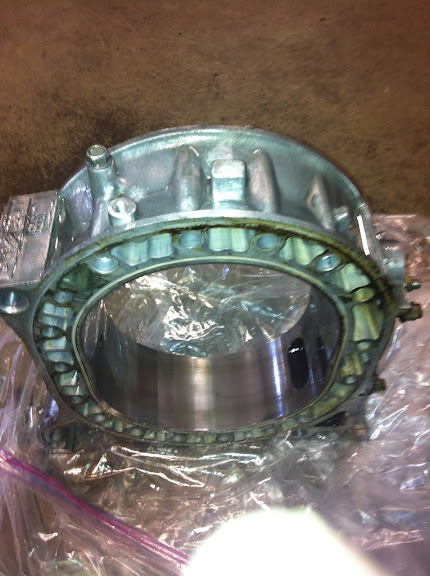
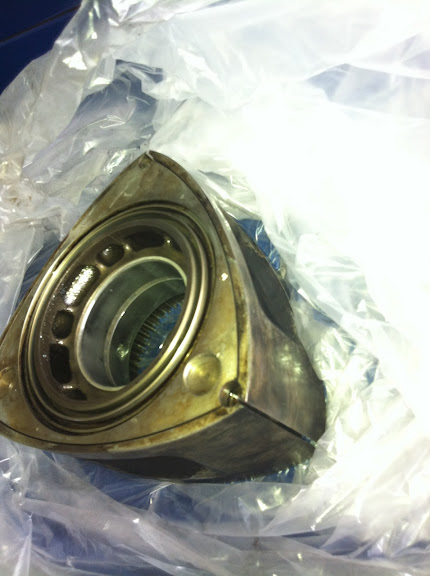

anybody got any ideas about porting the exhaust runners, manifold, wastegate while using a stock ecu?
still needs some more cleaning but starting too look alot better
mostly just cleaned the crap off the outside
anybody got any ideas about porting the exhaust runners, manifold, wastegate while using a stock ecu?
#9
i don't really run the Atkins apex seals on turbo engines unless they are stock any longer, the seals are about as reliable as OEM but a little better since when they fracture they generally just take a single small chunk out of the tip of the seal which saves the rotor, housing and turbo. there are more reliable apex seals on the market now which sacrifice a little life expectancy from the engine for a more durable seal material. the Atkins seals do last nearly as long as OEM seals do though, compared to the factory 2 piece seals, longer than the stock 3 piece the engines were built with.
i personally use Goopy seals on most of our upper end builds, RA super seals are also well known for durability. i have never tested the ALS seals though, not really a need since the other 2 do the job for less. Goopy is a nice alternative since they make oversize apex seals(for worn rotor seal slots) and why i opted to give them a shot and haven't been let down yet.
i personally use Goopy seals on most of our upper end builds, RA super seals are also well known for durability. i have never tested the ALS seals though, not really a need since the other 2 do the job for less. Goopy is a nice alternative since they make oversize apex seals(for worn rotor seal slots) and why i opted to give them a shot and haven't been let down yet.
Last edited by RotaryEvolution; 10-01-12 at 08:21 PM.
#10
I like Atkins because my experience says that they are very housing-friendly. 50k of use and the housings still looked like they did when I assembled the engine.
I have a set of FC 9.4 rotors that I'd like to use, but the slots are worn .002 oversize where the Atkins corner piece beat them apart. Being able to re-use them would be nice, but not if it means wrecking a set of hard-to-find GSL-SE rotor housings.
The problem wasn't due to the Atkins seal design, BTW. Dust killed that engine. So much abrasive crap went through that engine that the apex seals were worn to 1.6mm thickness and the area where the springs ride was so far gone that there wasn't any spring tension anymore. (This is the same engine that wore the side seals down to .104" height and put .025" grooves in the side housings) I'm assuming that the corner piece wore the rotor because it was bearing on a smaller surface than the main part of the seal.
Air filters. Use 'em.
#11
ive done one pull down at 1500 km on what where tired already 12a housings on a BP with goopy 3mm OS
and the housings and apex slots where standing up very well
no issues with the apex seals whatsover,, engine had broken a side seal and part of it was missing
but NIL damage to plates or housings says the apex seals pushed it out though the exhaust and no marks on any of them
PS goopy where chosen exactly for reason of the OS option.. MDR 12a rotors are desired but rare as hell and all have wear from the wedge end of the apex seal
its a lot of hard work with a hand file .. and you always have this numbing fear that your not getting it so straight.. but looking at those seals on the sides and in the slots and i was pretty happy they where a good choice
another good bonus is they use the longer wedge end like the atkins seals
and the housings and apex slots where standing up very well
no issues with the apex seals whatsover,, engine had broken a side seal and part of it was missing
but NIL damage to plates or housings says the apex seals pushed it out though the exhaust and no marks on any of them
PS goopy where chosen exactly for reason of the OS option.. MDR 12a rotors are desired but rare as hell and all have wear from the wedge end of the apex seal
its a lot of hard work with a hand file .. and you always have this numbing fear that your not getting it so straight.. but looking at those seals on the sides and in the slots and i was pretty happy they where a good choice
another good bonus is they use the longer wedge end like the atkins seals
Last edited by bumpstart; 10-01-12 at 11:16 PM. Reason: PS
#12
The engine should see quite a bit of track use, but I don't have any intention of upping the boost, it will stay at 10psi max so I don't need to change fueling or the ecu.
The thing I like about the Atkins kit is that it seems you get all the gaskets for outside the engine as well, stuff like manifold gaskets and whatnot.
Anybody have any experience with rotary aviation rebuild kits? They don't have the gaskets for outside like Atkins but I wouldn't think that would be hard to order seperate.
The thing I like about the Atkins kit is that it seems you get all the gaskets for outside the engine as well, stuff like manifold gaskets and whatnot.
Anybody have any experience with rotary aviation rebuild kits? They don't have the gaskets for outside like Atkins but I wouldn't think that would be hard to order seperate.
#13
How hard are they on rotor housings?
I like Atkins because my experience says that they are very housing-friendly. 50k of use and the housings still looked like they did when I assembled the engine.
I have a set of FC 9.4 rotors that I'd like to use, but the slots are worn .002 oversize where the Atkins corner piece beat them apart. Being able to re-use them would be nice, but not if it means wrecking a set of hard-to-find GSL-SE rotor housings.
The problem wasn't due to the Atkins seal design, BTW. Dust killed that engine. So much abrasive crap went through that engine that the apex seals were worn to 1.6mm thickness and the area where the springs ride was so far gone that there wasn't any spring tension anymore. (This is the same engine that wore the side seals down to .104" height and put .025" grooves in the side housings) I'm assuming that the corner piece wore the rotor because it was bearing on a smaller surface than the main part of the seal.
Air filters. Use 'em.
I like Atkins because my experience says that they are very housing-friendly. 50k of use and the housings still looked like they did when I assembled the engine.
I have a set of FC 9.4 rotors that I'd like to use, but the slots are worn .002 oversize where the Atkins corner piece beat them apart. Being able to re-use them would be nice, but not if it means wrecking a set of hard-to-find GSL-SE rotor housings.
The problem wasn't due to the Atkins seal design, BTW. Dust killed that engine. So much abrasive crap went through that engine that the apex seals were worn to 1.6mm thickness and the area where the springs ride was so far gone that there wasn't any spring tension anymore. (This is the same engine that wore the side seals down to .104" height and put .025" grooves in the side housings) I'm assuming that the corner piece wore the rotor because it was bearing on a smaller surface than the main part of the seal.
Air filters. Use 'em.
this was their seals in an engine that had resurfaced housings, so perhaps it could have been that combination even though i have used their seals in resurfaced housing engines before without any noticable significant wear. they may have snuck in a revision to the materials they make their seals out of, they also have cryo treated seals. in any case, warranty is too costly to take gambles with this issue.
the Goopy seals i haven't been running for a very long time but i have been running them in the more abused engines and have had zero issues with compression loss in those engines. the seals are softer so they should sacrifice themselves to save the rest of the engine wear. this isn't always the case but so far it has seemed to hold true.
i will have more definitive results when i tear down a 15k mile engine that was running about 500WHP in several weeks running the Goopy seals, it had lost a coolant seal but no other symptoms besides rough start after a day or so(coolant in the engine).
the recent Atkins seal failure engine was running filters, OMP delete, 124:1 premix, post turbo water injection and a modest engine break in. no discernable reason for the failure.
Last edited by RotaryEvolution; 10-02-12 at 01:43 PM.
#15
my experience with Atkins has been fair, but many times the engines did die due to the result i mentioned, a chipped apex seal tip under light detonation/leaning out. the seals hold up very well for long periods of time in sub 250WHP engines and last a good long time.
the recent Atkins seal failure engine was running filters, OMP delete, 124:1 premix, post turbo water injection and a modest engine break in. no discernable reason for the failure.
the recent Atkins seal failure engine was running filters, OMP delete, 124:1 premix, post turbo water injection and a modest engine break in. no discernable reason for the failure.
Since I'm trying to do this cheap I'll probably just run premix and delete the oil metering pump.
I also want to run water injection probably just a simple boost actuated system.
Seems like most of the people saying Atkins seals are fine are running fc's don't turbo'd fc run lower boost than an FD? Might use an Atkins kit- the apex seals I think
#16
FCs run less power due to the cumulative size of the turbos, even an FD pushing the same 7psi would make more power since the turbos combined are about 1.5 times the size of the stock single turbo FC.
#17
this was their seals in an engine that had resurfaced housings, so perhaps it could have been that combination even though i have used their seals in resurfaced housing engines before without any noticable significant wear. they may have snuck in a revision to the materials they make their seals out of, they also have cryo treated seals. in any case, warranty is too costly to take gambles with this issue.
the recent Atkins seal failure engine was running filters, OMP delete, 124:1 premix, post turbo water injection and a modest engine break in. no discernable reason for the failure.
Now, my filler neck is routed to my airbox, I keep one or two spare air filters pre-oiled and ready to go to be swapped out on a moment's notice, and I smoke-test the intake to find any trace of a vacuum leak. This is how old guys get to be absurdly ****-retentive about details.
#21
my bikes always ran in dusty environments, an oiled and decent filter was a must as well as good flow for performance. all these auto filters now are garbage.
Last edited by RotaryEvolution; 10-03-12 at 04:45 PM.
#24
Engine, Not Motor
iTrader: (1)
Joined: Feb 2001
Posts: 29,793
Likes: 119
From: London, Ontario, Canada
The thing I like about the Atkins kit is that it seems you get all the gaskets for outside the engine as well, stuff like manifold gaskets and whatnot.
Anybody have any experience with rotary aviation rebuild kits? They don't have the gaskets for outside like Atkins but I wouldn't think that would be hard to order seperate.
Anybody have any experience with rotary aviation rebuild kits? They don't have the gaskets for outside like Atkins but I wouldn't think that would be hard to order seperate.


